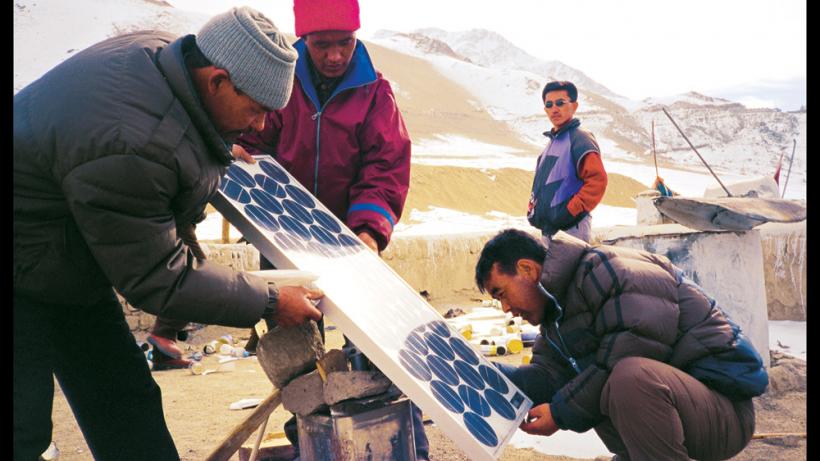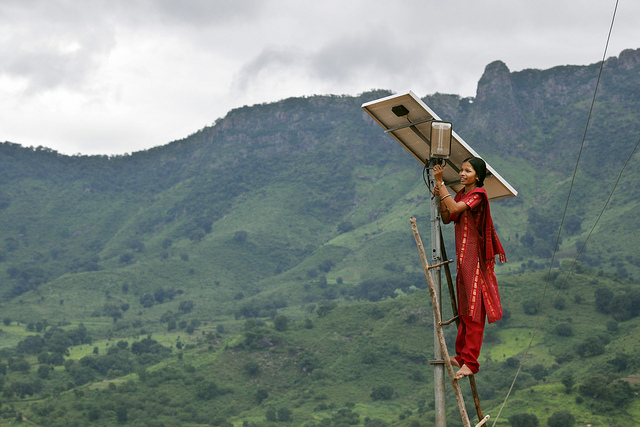
Let them buy light in rural Bihar
Access to electricity is critical to encouraging growth and reducing poverty. Around the world, 1.3 billion people have no access to electricity, including 300 million Indian citizens, most of whom live in rural areas. Micro-grid products could provide an innovative solution, bridging the gaps in access to electricity with potentially large economic and welfare gains to households.
The electricity sectors in developing countries are woefully inefficient, and their rapid growth will not be sustainable if they rely primarily on burning fossil fuels. Therefore, small decentralised energy projects have an important role to play in providing universal access and reducing the carbon-intensity of electricity load growth.
A solar micro-grid product for villages in Bihar
We partnered with Husk Power Systems (HPS), a company that had already won accolades for its innovative rice husk biomass micro-grid product. Our goal was to examine the demand for solar energy in villages with few other electricity options, and to study the causal effect of electricity on household welfare characteristics such as health, education, and income generation. In 2012, HPS began piloting a solar micro-grid product that would provide consumer households with energy supply to 2 LED bulbs and 1 mobile charger for 5-7 hours per day. Working in collaboration with Husk Power System’s roll-out, we able to design a randomised control trial with two randomly selected groups—the treatment group will receive the intervention and the control group will not. One group of treatment villages will be able to purchase the solar connection at a subsidized rate of INR 100 per month, while another group will be offered the connection at the unsubsidised price of INR 200 per month. This is a powerful experimental design, as it will allow us to directly compare two groups who have the same characteristics all other ways, the only difference being access to electricity.
Village-level demand for solar energy
Over the course of the project, we hoped to gain insight into the demand for solar power in rural areas with few other electrification options. To accomplish this, we measured both the stated and actual willingness-to-pay of households in our sample villages.
Before the rollout, we asked potential customers how much they would be willing to pay for different appliance bundles. We found a very large stated willingness to pay for entertainment appliances, such as a television set. For example, households have stated that they are willing to pay approximately INR 40 per month for one CFL or LED bulb and an additional INR 90 per month for a television, adding to a total of INR 130 per month.

Image credit: DFID - UK Department for International Development
Once HPS began installing panels in interested households, we collected monthly data on actual customer take-up and re-charges in both subsidy and non-subsidy villages. This has allowed us to estimate demand curves by fitting the number of solar micro-grid customers in each village against the total number of households in the village (see Figures 1 & 2 below). This take-up data suggests that at a price of INR 200 per month, demand does not increase as village size gets larger. On the contrary, it declines. We believe that this may be due to the fact that larger villages are more likely to have diesel generator options, which are HPS’s main competitors. At a subsidised price of INR 100 per month, however, the HPS solar micro-grid product is competitive, and there is strong demonstrated customer demand. In response to this data, HPS lowered the normal price of their product to INR 160, as the resulting increase in customer demand and recharges actually made it more cost-effective for the company.
Figure 1: Demand for Connections at Subsidised Price (INR 100 per month)

Figure 2: Demand for Connections at INR 200 per month

Household and business welfare impacts of electrification
Our baseline survey provided insights on the characteristics of electrified and un-electrified households. Sample villages for this project were selected based on a limited access to government electricity infrastructure, and so over 70% of households did not have access to electricity from any source when the project started. In order to meet their primary requirements of lighting and phone charging, households may have the possibility of choosing between grid electricity, solar panels, or diesel generators. Of these sources, diesel generators are by far the most popular option, employed by 17% of our sample households at baseline. Diesel generators are usually operated by someone from the village who collects money from households every month. Connections to a diesel generator generally cost INR 70-120 per month, thus making it a very strong competitor to the HPS product at INR 200 per month.
Our baseline results point to correlations between electricity access and household welfare outcomes, controlling for income. For example, in households with electricity from any source, girls are more likely to attend school. Households with electricity are also more likely to use their cell phones for business purposes. These correlations could be due to the effect of electricity or other factors, like wealth, that are related to school attendance or entrepreneurship. Figure 3 shows the school attendance for children under the age of 16 years by access to electricity. Figure 4 shows that households with electricity are more likely to use their cell phones for business purposes, perhaps resulting in an increase in income generation activities such as micro-enterprises.
Figure 3: School Attendance, by Electricity Access

Figure 4: Mobile Phone Usage, by Electricity Access

As of May 2016, we are completing our endline survey, where we hope to be able to confirm causal effects on health, education, and income generation.

